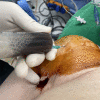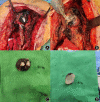Metallosis-Induced Conversion Shoulder Arthroplasty: A Unique Experience and Literature Review
- PMID: 37526172
- PMCID: PMC10549855
- DOI: 10.1111/os.13832
Metallosis-Induced Conversion Shoulder Arthroplasty: A Unique Experience and Literature Review
Abstract
Background: Total shoulder arthroplasty (TSA) can fail for several reasons, such as component loosening, periprosthetic fracture, instability, infection, soft tissue failure, or joint overstuffing. Severe metallosis without loose glenoid components after TSA may result in the need for revision to reverse TSA.
Case presentation: Four years before the current presentation, an 86-year-old woman suffered from right shoulder pain and swelling. The initial diagnosis was osteoarthritis of the shoulder joint, for which she underwent TSA. Four years later, she complained of shoulder joint pain, swelling, and limited range of motion. On sonography, subscapularis and supraspinatus tendon tears were identified. Plain radiographs and computed tomography (CT) scans showed metallosis around the shoulder joint. Due to the rocking horse mechanism, wear of the upper portion of the glenoid component and bearing caused a foreign-body reaction and severe metallosis around the joint. Due to a massive rotator cuff tear combined with glenoid component wear, the patient eventually underwent reverse TSA (RTSA) and was satisfied with the final results.
Conclusions: Severe metallosis due to glenoid component wear combined with a massive rotator cuff tear in TSA may cause the need for revision to RTSA.
Keywords: Prosthesis Loosening; Reverse; Rotator Cuff Tears; Total Shoulder Arthroplasty; Total Shoulder Arthroplastymetallosis.
© 2023 The Authors. Orthopaedic Surgery published by Tianjin Hospital and John Wiley & Sons Australia, Ltd.
Conflict of interest statement
The authors declare no potential conflicts of interest with respect to the research, authorship, and/or publication of this report.
Figures





Similar articles
-
Similar rates of revision surgery following primary anatomic compared with reverse shoulder arthroplasty in patients aged 70 years or older with glenohumeral osteoarthritis: a cohort study of 3791 patients.J Shoulder Elbow Surg. 2023 Sep;32(9):1893-1900. doi: 10.1016/j.jse.2023.03.021. Epub 2023 Apr 17. J Shoulder Elbow Surg. 2023. PMID: 37075936
-
Outcomes after shoulder replacement: comparison between reverse and anatomic total shoulder arthroplasty.J Shoulder Elbow Surg. 2015 Feb;24(2):179-85. doi: 10.1016/j.jse.2014.06.039. Epub 2014 Sep 9. J Shoulder Elbow Surg. 2015. PMID: 25213827
-
Reverse shoulder arthroplasty with preservation of the rotator cuff for primary glenohumeral osteoarthritis has similar outcomes to anatomic total shoulder arthroplasty and reverse shoulder arthroplasty for cuff arthropathy.J Shoulder Elbow Surg. 2023 Jun;32(6S):S60-S68. doi: 10.1016/j.jse.2023.02.005. Epub 2023 Feb 21. J Shoulder Elbow Surg. 2023. PMID: 36813228
-
Comparison of Survivorship and Failure Modes Between Anatomic and Reverse Total Shoulder Arthroplasty Across Multiple Government Joint Registries for a Single Platform Shoulder System.Bull Hosp Jt Dis (2013). 2023 Jun;81(2):141-150. Bull Hosp Jt Dis (2013). 2023. PMID: 37200333 Review.
-
Revision of the loose glenoid component in anatomic total shoulder arthroplasty.Bull Hosp Jt Dis (2013). 2013;71 Suppl 2:68-76. Bull Hosp Jt Dis (2013). 2013. PMID: 24328585 Review.
References
Publication types
MeSH terms
LinkOut - more resources
Full Text Sources
Medical
Research Materials

